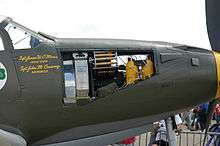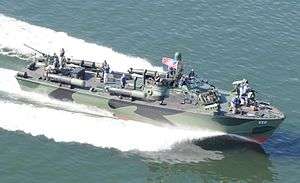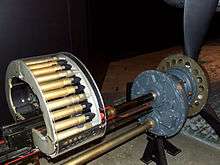M4 cannon
| 37 mm Automatic Gun, M4 | |
|---|---|
 | |
| Type | Autocannon |
| Place of origin | United States |
| Service history | |
| In service | 1942 |
| Used by |
United States Soviet Union |
| Wars | World War II |
| Production history | |
| Designer | John Browning |
| Designed | 1921-1938 |
| Manufacturer | Colt |
| Produced | 1939 |
| Specifications | |
| Weight | 213 lb (97 kg) |
| Length | 89.5 in (2.27 m) |
|
| |
| Shell | 37x145mmR M4 |
| Caliber | 37 mm (1.46 in) |
| Action | recoil operation |
| Recoil | 9⅝ in (245 mm) |
| Rate of fire | 150 rpm |
| Muzzle velocity | 2,000 ft/s (610 m/s) |
| Feed system | 30-round magazine |
The 37 mm Automatic Gun, M4, known as the T9 during development, was a 37 mm (1.46 in) recoil-operated autocannon designed by Browning Arms Company.[1] The weapon, which was built by Colt, entered service in 1942. It was used in the Bell P-39 Airacobra and P-63 Kingcobra.
Design
Designed primarily as an anti-aircraft weapon, the gun had a muzzle velocity of 2,000 ft/s (610 m/s) and a cyclic rate of 150 rounds per minute. It was normally loaded with high-explosive shells, but could also be loaded with the M80 armor-piercing shell, which could penetrate 1 inch (25 mm) of armor plate at 500 yd (460 m). It was magazine-fed and could be fired manually or by remote control through a solenoid mounted on the rear of the gun.
Recoil and counter-recoil were controlled hydraulically by means of a piston and spring combination connected to the recoiling mechanism and operating in an oil-filled recuperator cylinder mounted to the stationary trunnion block assembly. The recoiling mechanism of the gun included the tube and tube extension, recuperator piston and piston rod, lock frame assembly, driving spring assemblies, and the breechblock assembly. The nonrecoiling parts included the trunnion block group, the feed box and feeding mechanism, the recuperator cylinder and bushing, the back plate group, and the manual charger assembly.
Feeding mechanism
As the gun was originally designed, ammunition could be fed by a 5-round clip, a 15-round link belt, or a non-disintegrating 30-round endless belt magazine. The 30-round endless belt version was used exclusively in production. The M4 gun fed only from the left.
The 30-round endless belt magazine was given the designation M6; it had an oval-shaped framework (nicknamed a "horsecollar magazine" from its shape) providing a track for the endless belt.[2][3][4]
Firing cycle
Initial loading and cocking of the gun were accomplished manually. A safety feature incorporated in the design of the trigger mechanism prevented firing the round until the breech-block assembly was in the battery position.
The breech was locked and unlocked by recoil action which brings the operating level guide pins against cams to raise and lower the breechblock. The function of the breechblock was to assist in the final chambering of the round, close the breech, and actuate the trigger trip. It also provided a mounting for the firing pin.
The lock frame was retracted by recoil action during automatic firing and is forced forward by the driving springs. The major function of the lock frame assembly was to force the cartridge into the chamber, actuate the breech block, fire the round by means of the hammer striking the firing pin, extract the cartridge case from the chamber, and operate the ejector.
The back plate assembly, by absorbing the energy of the lock frame, reduced the shock against the carrier pin as the lock frame was hatched to the rear.
The driving spring assemblies held the lock frame against the carrier dog until the carrier was released by carrier catch which was pivoted by the incoming round. The springs then drove the lock frame assembly forward to operate the ejector, chamber the round and raise the breech block.
Initial extraction occurred during recoil. Extraction, ejection, feeding and loading were accomplished during counter-recoil. If the trigger was held in the firing position, the gun would continue to fire automatically until the magazine was empty.
US Army Air Forces

The 37 mm cannon was disliked by pilots for its drooping trajectory.
The only standard aircraft armed with the M4 to see service were the Bell P-39 Airacobra and the derivative P-63 Kingcobra. It was used as a limited standard aircraft in North Africa and the Pacific theater by the USAAF and Allied air forces.
The experimental XP-58 "Chain Lightning" was a larger, more heavily armed version of the P-38 Lightning equipped with quadruple M4 cannons instead of M2 heavy machine guns in its nose. Its original purpose (like the German Bf-110) was to destroy formations of bombers, but it was later re-envisioned as a ground-attack plane. The drooping arc of fire was unfamiliar for American pilots, and the four M4s were replaced with a single 75mm M5 cannon and a pair of .50 heavy machine guns.
US Navy

The M4 37 mm (1.46 in) automatic cannon was mounted on numerous U.S. Navy PT boats as deck guns, beginning with the Solomon Islands campaign. Primary targets were the landing barges being used to move supplies down the island chain at night. At first, they were cannibalized from crashed P-39s at Henderson Field, and due to their success as an anti-barge weapon were used for the rest of the war. The M4s were initially mounted on a simple pedestal mount (often built at the front lines) with the standard horseshoe endless-belt feed being used. Later, an improved pedestal mount was designed for original equipment mountings on the boats. Handgrips of several configurations were used with various sights being tried. Most PT boat gunners used tracers to sight the fall of their shot. Beginning in 1944, the M9 model 37 mm (1.46 in) cannon was installed at the builders' boatyard as standard equipment.

Soviet Air Forces
During World War II the United States supplied the Soviet Air Forces with the M4-equipped P-39 Airacobra and P-63 King Cobra. The U.S did not supply M80 armor-piercing rounds for these Lend-Lease aircraft—instead, the Soviets received 1,232,991 M54 high-explosive rounds. The M4 was sometimes used against soft ground targets but was primarily for air-to-air combat on the Eastern Front at which duty it was highly effective. The Soviets did not use the P-39 for tank-busting.[5] Soviet pilots appreciated the M4's reliability but complained of its low rate of fire (three rounds per second) and small magazine size (30 rounds).[6]
US-built contemporaries and successors
- The 37 mm M9 autocannon was a derivative of the 37 mm M1A2 flak gun and used the longer, more powerful 37×223mmSR cartridge. Compared to the M4, the M9 had 50% more muzzle velocity (3,000 fps) from a 78-inch barrel (vs. 65-inch in M4), and was twice as heavy (120 vs. 55 pounds for the barrel alone); the whole M9 weighted 405 pounds vs. 213 of the M4. The cyclic rate was the same.[7] Little is known about this gun's deployment; the only confirmed use is in the US Navy PT boats mentioned above.[8]
- The 37 mm M10 autocannon was a minor improvement of the M4. It was fed by metallic disintegrating link belt and had slightly higher rate of fire at around 165 rpm.[7] The belt made it possible to store more ammunition for the gun in the host aircraft, for a new total of 58 rounds. The M10 replaced the M4 in aircraft, starting with the A-9 model of the Bell P-63 Kingcobra.,[8]
See also
- List of U.S. Army weapons by supply catalog designation
- COW 37 mm gun : earlier British equivalent
Weapons of comparable role, performance and era
- Nudelman-Suranov NS-37, (Nudelman N-37) : Soviet equivalents
- Vickers S gun : 40-mm British equivalent
- Bordkanone BK 37 : German equivalent
Notes
- ↑ Bishop, Chris (2002). The Encyclopedia of Weapons of World War II. New York: Friedman/Fairfax Publishers. p. 161. ISBN 1-58663-762-2.
- ↑ Emmanuel Gustin; Anthony G. Williams (2003). Flying Guns: The Development of Aircraft Guns, Ammunition and Installations, 1933-45. Airlife. p. 153. ISBN 978-1-84037-227-4.
- ↑ Ian V. Hogg (2001). The American Arsenal: The World War II Official Standard Ordnance Catalog of Small Arms, Tanks, Armored Cars, Artillery, Antiaircraft Guns, Ammunition, Grenades, Mines, Etc. Greenhill Books. p. 217. ISBN 978-1-85367-470-9.
- ↑ Gordon Rottman (2011). US Patrol Torpedo Boats: World War II. Osprey Publishing. p. 22. ISBN 978-1-78096-208-5.
- ↑ Loza, Dmitriĭ Fedorovich (2002). Attack of the Airacobras: Soviet aces, American P-39's and the air war against Germany. University Press of Kansas. p. 359. ISBN 0-7006-1140-1.
- ↑ Drabkin, Artem. The Red Air Force at War: Barbarossa and the Retreat to Moscow – Recollections of Fighter Pilots on the Eastern Front. Barnsley, South Yorkshire, UK: Pen & Sword Military, 2007, p. 133. ISBN 1-84415-563-3.
- 1 2 George Chinn 1951, The Machine Gun: Development During World War II and Korean Conflict by the United States and their Allies of Full Automatic Machine Gun Systems and High Rate of Fire Power Driven Cannon, Volume III, Parts VIII and IX., p. 352
- 1 2 Anthony G. Williams (2002). Rapid Fire: The Development of Automatic Cannon, Heavy Machine-Guns and Their Ammunition for Armies, Navies and Air Forces. Airlife. pp. 155–156. ISBN 978-1-84037-435-3.
References
- War Department, U.S. Army Coast Artillery Corps, Training Manual TM-9-2300 Standard Artillery and Fire Control Materiel (7 February 1944)
- War Department, Training Manual TM 9-240 37-mm Aircraft Gun Materiel M4 (30 March 1942)
- War Department, Training Manual TM 9-1240 37-mm Automatic Gun M4 (Anti-aircraft) (3 January 1942)
- War Department, US Army Ordnance Corps, Standard Nomenclature List Catalog, Group A, Subgroup A46 ORD SNL A-46 (37mm Gun, Automatic, models M4 & M10)
- P-63 KingCobra - Browning M4 37mm Auto Cannon Gun
- United States of America 37 mm/56 (1.46") M4
External links
![]() Media related to M4 cannon at Wikimedia Commons
Media related to M4 cannon at Wikimedia Commons